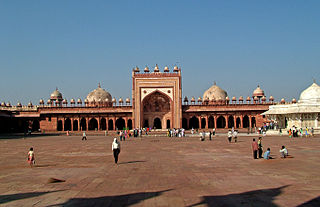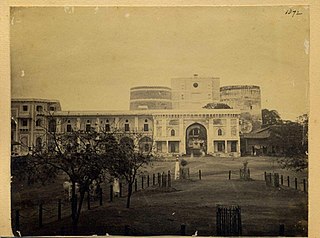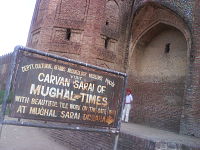Sarai, Serai, or Saraj may refer to:

The Lahore Fort is a citadel in the city of Lahore, Pakistan. The fortress is located at the northern end of walled city Lahore, and spreads over an area greater than 20 hectares. It contains 21 notable monuments, some of which date to the era of Emperor Akbar. The Lahore Fort is notable for having been almost entirely rebuilt in the 17th century, when the Mughal Empire was at the height of its splendour and opulence.
The Walled City of Lahore, also known as Old City, forms the historic core of Lahore, Pakistan. The city was established around 1000 CE in the western half of the Walled City, which was fortified by a mud wall during the medieval era.

The Architecture of Lahore reflects the history of Lahore and is remarkable for its variety and uniqueness. There are buildings left from the centuries of rule of the Mughal Empire, the Sikh Empire, as well as from the era of the British Raj, whose style is a mixture of Victorian and Islamic architecture often referred to as Indo-Saracenic. In addition, there are newer buildings which are very modern in their design. Unlike the emphasis on functional architecture in the west, much of Lahore's architecture has always been about making a statement as much as anything else.

Agra Fort is a historical fort in the city of Agra in India. It was the main residence of the rulers of Sikarwar clan of rajputs until mughals occupied it and Mughal Dynasty until 1638, when the capital was shifted from Agra to Delhi. It was also known as the “Lal-Qila”, “Fort Rouge” or “Qila-i-Akbari”. Before capture by the British, the last Indian rulers to have occupied it were the Marathas. In 1983, the Agra fort was life inscribed as a UNESCO World Heritage Site. It is about 2.5 km northwest of its more famous sister monument, the Taj Mahal. The fort can be more accurately described as the walled city.

Rohtas Fort is a 16th-century fortress located near the city of Jhelum in the Punjab province of Pakistan. The fort is one of the largest and most formidable in the subcontinent. Rohtas Fort was never taken by force, and it has survived remarkably intact.

Mughal architecture is the type of Indo-Islamic architecture developed by the Mughals in the 16th, 17th and 18th centuries throughout the ever-changing extent of their empire in the Indian subcontinent. It developed from the architectural styles of earlier Muslim dynasties in India and from Iranian and Central Asian architectural traditions, particularly Timurid architecture. It also further incorporated and syncretized influences from wider Indian architecture, especially during the reign of Akbar. Mughal buildings have a uniform pattern of structure and character, including large bulbous domes, slender minarets at the corners, massive halls, large vaulted gateways, and delicate ornamentation; examples of the style can be found in modern-day Afghanistan, Bangladesh, India and Pakistan.

NurMahal or Noor Mahal is a city and a municipal council in Jalandhar district in the Indian state of Punjab. It is a small town located near the Lohian Khas-Nakodar - Ludhiana line in Punjab. This town is also connected with the nearby towns of Phillaur and Nakodar by a road going along the railway lines. Nurmahal is situated 13 km from Nakodar, 33 km from Jalandhar. Many villages are close by to Nurmahal.
Pakistani architecture is intertwined with the architecture of the broader Indian subcontinent. With the beginning of the Indus civilization around the middle of the 3rd millennium BC, for the first time in the area which encompasses today's Pakistan an advanced urban culture developed with large structural facilities, some of which survive to this day. This was followed by the Gandhara style of Buddhist architecture that borrowed elements from Ancient Greece. These remnants are visible in the Gandhara capital of Taxila.

The Jama Masjid is a 16th-century congregational mosque in the UNESCO World Heritage Site of Fatehpur Sikri in Uttar Pradesh, India. Constructed by Mughal Emperor Akbar, it is one of the largest mosques in India. It is the most sought after pilgrimage site by the devotees. It is also one of the most visited tourist destinations in Agra district. Some of the designs of the mosque reflect beautiful Iranian architecture.

Jahanpanah was the fourth medieval city of Delhi established in 1326–1327 by Muhammad bin Tughlaq (1325–51), of the Delhi Sultanate. To address the constant threat of the Mongols, Tughlaq built the fortified city of Jahanpanah subsuming the Adilabad fort that had been built in the 14th century and also all the establishments lying between Qila Rai Pithora and Siri Fort. Neither the city nor the fort has survived. Many reasons have been offered for such a situation. One of which is stated as the idiosyncratic rule of Mohammed bin Tughlaq when inexplicably he shifted the capital to Daulatabad in the Deccan and came back to Delhi soon after.

Aam Khas Bagh is the remains of a highway-inn constructed for the use of royalty as well as common people. It was divided into two parts - the Aam for public use and the Khas for private use by the Royalty. This Royal inn was initially built by Akbar and planned by Mughal architect Hafiz Rakhna. It was rebuilt by Mughal Emperor Shah Jahan along the Mughal military road between Delhi and Lahore. The Royal couple used to stay here in the old building complex while going to and coming back from Lahore. Later on, some additions were made to this monument by Mughal Emperor Jahangir.

Serai Nurmahal or Mughal Serai is an inn of historical importance located at Nurmahal, near Jalandhar.

Serai Lashkari Khan located near Gurdwara Manji Sahib, Kotan in Ludhiana District, Punjab, India is a historical inn built by Mughal military general Lashkari Khan, in the reign of Emperor Aurangzeb in 1667 CE.

The Badshahi Mosque is a Mughal-era congregational mosque in Lahore, capital of the Pakistani province of Punjab, Pakistan. The mosque is located west of Lahore Fort along the outskirts of the Walled City of Lahore, and is widely considered to be one of Lahore's most iconic landmarks.

Bhadra Fort is situated in the walled city area of Ahmedabad, India. It was built by Ahmad Shah I in 1411. With its well carved royal palaces, mosques, gates and open spaces, it was renovated in 2014 by Ahmedabad Municipal Corporation (AMC) and Archaeological Survey of India (ASI) as a cultural centre for the city.

The Akbari Sarai is a large caravan inn ("sarai"), located in Shahdara Bagh in Lahore, Punjab, Pakistan. Dating from 1637, the sarai was originally built for travelers, as well as for caretakers of the Tomb of Jahangir. The sarai is most notable for being the best-preserved example in Pakistan, as well as for its large gateway that is richly embellished with pietra dura that serves as a portal to the tomb of Jahangir.

The Tomb of Asif Khan is a 17th-century mausoleum located in Shahdara Bagh, in the city of Lahore, Punjab. It was built for the Mughal statesman Mirza Abul Hassan Jah, who was titled Asif Khan. Asif Khan was brother of Nur Jahan, and brother-in-law to the Mughal Emperor Jahangir. Asif Khan's tomb is located adjacent to the Tomb of Jahangir, and near the Tomb of Nur Jahan. Asif Khan's tomb was built in a Central Asian architectural style, and stands in the centre of a Persian-style Charbagh garden.

Arab Serai is a 16th century caravanserai within the Humayun's tomb complex at Delhi, India. It is said to have been built by Mughal emperor Humayun's widow Haji Begum. In recent times, it has been conserved by Aga Khan Trust for Culture.



















